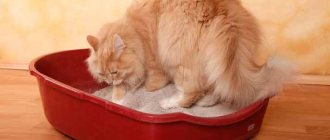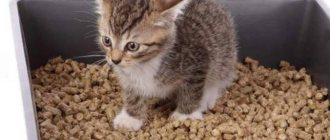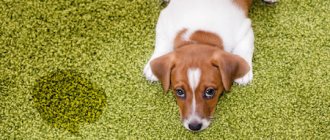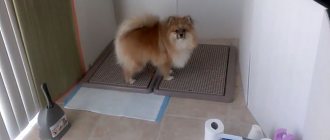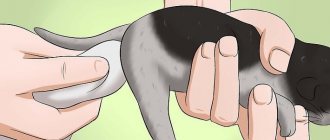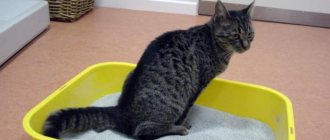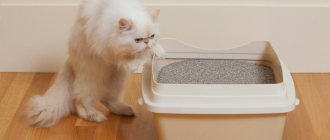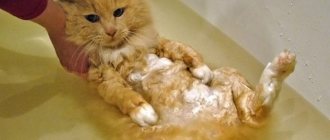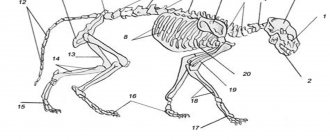10216Administration
There are certain standards regarding how many times a day a cat should pee. They depend on a number of factors, including age, body weight, type of feeding, gender and lifestyle of the pets. It is generally accepted that deviations from these norms, up or down, are a signal of problems in the body. But this is a relative statement, since it is impossible to say with milliliter precision how much urine an animal’s body should produce, based on the many nuances associated with this issue. Here we can only talk about average indicators, provided that the cat is healthy.
How many times a day do you urinate?
The norm depends on many factors: age, gender, weight, diet and lifestyle.
Since newborn kittens have a small bladder, they pee on average 10 times a day. At 3 months, the frequency of urination in kittens decreases to 7-8 times. Upon reaching 6 months, the norm for kittens is 5-6 times per day. As the baby grows older, he begins to write less often - 3-4 times a day.
The frequency of urination varies between male and female cats. This is due to the structural features of the urinary system of animals. Since cats have a narrower canal structure, he must pee more often than a cat. A male pet can go to the toilet up to 5 times a day. Cats go to the toilet 1 to 3 times a day.
Normal frequency of urination in cats
While the pets are still very small, and their age does not exceed 3 months, there is no need to worry that the kittens go to the toilet only once a day: their urinary system is not yet perfect, and its basic formation is yet to come. Starting from 3 months, babies can write more – 2-3 times a day.
If a six-month-old pet visits the litter box even 6 times a day, this is also not scary, provided that there are no signs of his illness. It’s just that at this age the kitten is still very active, plays and runs a lot, which means it drinks more water. This is what causes the frequent urge to pee. Over time, the pet will learn to consume liquid moderately, and 5 visits to the toilet will be an acceptable maximum.
If we take into account that gender also matters in the question of how many times a day a cat urinates, then adult “male” pets (a year and older) pee about 2 times more often than cats. This is due to several reasons:
- the urinary ducts of cats are thinner than those of cats;
- the shape of the channels is more curved, which does not allow all urine produced to be removed at once, and you have to pee more often;
- after castration, the width of the canals narrows even more.
In total, it turns out that the norm for an adult male is from 3 to 4 times a day (but sometimes 6 times - still an acceptable norm for castrated pets).
If animals are very active and mobile, then, like small kittens, they have a greater need for water and, accordingly, pee often. But some lazy bumpkins, due to their passive lifestyle, can endure to the last and go to the toilet relatively little - only once a day. If there are no signs of disease, there is nothing to worry about, but it is still advisable to try to involve such a pet in active games in order to avoid obesity, which can lead to problems with urination.
If the basis of your pet’s diet is dry food, such food makes the animal thirsty more often. Therefore, water must always be available. Increased fluid consumption provokes more frequent urination, but here owners must more carefully monitor not only the quantity, but also the quality of urine:
- whether there are any foreign impurities in it;
- Is there enough quantity or are the portions meager?
- what is the behavior of the animal when going to the toilet.
This is important to control, because cats that sit closely on dry food are more susceptible to developing urolithiasis, and especially neutered pets. Of course, here we are talking about those cases when the food is not selected specifically for operated animals, is not premium, and the water required for such a diet is not always enough.
Situations arise in which the animal may visit the toilet less often. It is important to understand in which cases this is a safe deviation from the norm, and in which cases you should consult a doctor.
Physiological
If deviations from the norm occur infrequently, there is no need to worry. The frequency of urination is normalized naturally.
Main reasons:
- change of feed;
- climate change;
- stress in the animal;
- castration or sterilization.
In case of castration or sterilization, the pet’s condition stabilizes within 3–4 days in males and several weeks in females.
A normal trip to the toilet is the key to the health of your furry pet. To notice the first signs of his illness, you need to pay attention to how often he pees. At the same time, the animal owner is faced with the question of how many times a day a kitten should pee.
The number of trips to the toilet is different for kittens of different ages. This is due to the animal’s diet and the degree of development of the gastrointestinal tract. Let's look at the average toilet visit rates for kittens according to their age.
A newly born kitten cannot go to the toilet on its own. He relieves his natural needs with the help of his mother cat. She massages his tummy while she licks him, working on his anal sphincters and urinary canal, causing him to pee and poop. This procedure is carried out 7 to 10 times a day. If the kitten has a swollen tummy and is acting restless, it means the cat is not caring for it properly and feces or urine are not being excreted.
We suggest you read: What is the normal temperature for cats?
At three weeks, a small kitten’s gastrointestinal tract is already quite mature. From this moment on, liquid food is gradually introduced into his diet, without weaning the baby from mother's milk. During the period of introducing complementary foods, you need to pay attention to whether the animal can poop or pee on its own. The kitten should go to the toilet 3-6 times for this purpose.
How often kittens pee between 3 and 4 months old depends on their diet and time of year. It is considered normal if a kitten pees 3-6 times a day. Since in extreme heat the animal begins to drink more, these indicators change somewhat. In the summer he pees 4 to 7 times.
Adult kitten
At six months the pet becomes quite large. By this time, his digestive system is completely formed. The pet itself gets used to a certain diet. Depending on how he is fed and whether water is openly available, a kitten will pee an average of 5 times a day.
Those who have just bought themselves a mustachioed and striped friend often ask how many times a day a cat should pee. These animals initially existed with a lack of moisture, so they drink little, and their urine is extremely concentrated. Actually, this is what causes the specific and well-recognized smell of cat urine.
There is no need to be alarmed if your cat does not pee several times a day; it may happen once or twice a day. In principle, this is within normal limits, especially if the animal receives wet food and drinks very rarely and little.
In addition, a caring cat constantly licks her kittens, so it may seem as if they are not urinating at all. Only after children begin to feed themselves can owners notice that they go to the toilet infrequently. This is also the norm for animals up to one and a half to two months.
It’s another matter if owners notice urinary problems in older animals. Normally, they can urinate 1–2 times a day. Frequent urination may indicate the presence of chronic renal failure (CRF), and too infrequent urination may indicate various health problems, including urolithiasis, which is very dangerous for cats.
Why do problems with stool occur?
When planning to have a furry pet, future owners must understand the responsibility they take on for the life and health of their beloved cat. It is very important to provide proper care, create optimal living conditions, and think through the diet. The period of adaptation and socialization should be favorable, without stress. Any negative factors can weaken the immunity of animals and provoke changes in behavior and the functioning of internal organs and systems.
If an older kitten has a normal appetite, eats well, but there is no bowel movement, the fluffy does not go to the toilet, this condition can be provoked by various factors.
- Stress. A change of place of residence, a trip to the veterinary clinic, the presence of other animals in the house, and other stressful situations can lead to the absence of defecation. The kitten may not poop or go to the toilet for two or three days.
- Early weaning from the cat. Missing his mother in his new home, the fluffy may experience problems with bowel movements for up to four to five days. This is normal, but if the situation does not change, seek help from a veterinarian.
- Unbalanced nutrition, sudden changes in diet, consumption of foods rich in protein. In the first weeks and months, try to give your pet the same food that he received from his previous owners. Introduce new products gradually. You should not change your diet suddenly. If the baby is kept on a natural diet, do not suddenly switch the animal to ready-made food.
- Helminthic infestations. Constipation in young kittens can be caused by worms. Intestinal parasites disrupt digestive processes, worsen general condition, and can cause intestinal blockage.
You need to accustom your kitten to new foods and solid food gradually, in small portions. In order not to disrupt the digestive processes, solid food should be crushed and mixed with milk and boiled water to a creamy consistency.
Important! For kittens aged three to five weeks, the food used for complementary feeding should be at room temperature, liquid, semi-liquid consistency.
If your baby cannot poop for more than five to seven days or experiences discomfort during bowel movements, consult your veterinarian. The cause of this condition can be health problems, systemic disorders in the functioning of internal organs and systems. If your kitten often suffers from constipation, consult your veterinarian and adjust your pet’s diet.
When kittens start going to the toilet on their own, how often do they do it?
How often kittens urinate depends on how thick their food is and how much liquid they drink. Since a small animal has a smaller bladder, it pees more often than an adult. If the kitten is not sick, then until the age of two months it will visit the toilet about 10 times. The older your pet gets, the less often he pees. Infrequent urination will also occur if the kitten is switched to thicker food or is limited in water.
HOW MANY TIMES A DAY DOES YOUR CAT PEE?
This is not a funny question at all, but an indicator of your pet's health. Every caring cat owner should know how many times a healthy cat goes to the toilet. Of course, many may experience minor deviations that do not pose a threat to the health of the pet. But if deviations occur frequently, then this should alert the owners.
The frequency of visiting the litter box depends on the pet’s age, gender, weight, nutrition and lifestyle. Kittens do not pee as often if they are less than 3 months old. Their normal urination stabilizes only by 1–1.5 months. Little cubs can pee no more than once a day. By 3-4 months, urination increases up to 2-3 times.
How does this happen with an adult cat? The differences in urination between adult cats and female cats are minor, but they still exist. For a cat, the norm is 1–2 times a day, and for cats – 3–4 times. The differences are associated with the specific structure of the urinary system. A male animal, and a castrated one, can go to the toilet up to 5 times a day with normal nutrition.
Cats, including sterilized animals, pee 1 to 3 times a day with normal nutrition. Of course, each animal has individual characteristics that lead to MINOR DEVIATIONS from the norm. Safe deviations can be considered those that are the result of a number of factors affecting the general condition of your pet:
- the cat is stressed. Stress can disrupt a cat's routine. The pet can walk a little once every 1-2 days;
- climate change;
- change of feed;
- carrying out sterilization or castration.
As for sterilization and castration, it takes up to 2-3 days for cats to restore function. Neutered cats take longer days because they undergo deep surgery. PATHOLOGICAL DEVIATIONS FROM THE NORM should be considered situations when your cat does not go to the toilet for more than 2 days or urination is difficult and comes in scanty doses.
- lack of urination;
- difficulty urinating with scanty discharge;
- it is painful for the animal to go to the toilet, which is expressed by frequent meowing;
- the presence of various impurities in the urine (blood, mucus, sand);
- apathy, bad mood;
- lack of appetite;
- elevated temperature;
- general poor health (dry and hot nose, hot tips of the ears, pale and unhealthy-looking gums);
- swelling in the abdominal area.
First of all, it is necessary to exclude URINARITY, KIDNEY DISEASE. They often occur due to hypothermia, as well as poor nutrition, cheap feed, and poor animal hygiene. They affect cats more, both regular and neutered, due to the specific structure of the genitourinary system.
As we said above, if the animal has no desire to go to the toilet for more than two days, the pet does not feel well, its stomach is swollen, or there are any impurities in the urine, then immediately contact a veterinarian. If the disease progresses, surgery may be required.
- feed your cat or cat in a balanced manner (2-3 times a day);
- give clean water;
- include in the diet not only dry food, but also canned food, boiled chicken, meat, dairy products, except milk;
- wash the tray thoroughly;
- keep the house clean;
- do not allow the animal to become hypothermic;
- notice changes in your pet’s behavior in time and contact a veterinarian.
The health of cats depends primarily on their diet. As a rule, kidney and bladder diseases often occur in overweight cats. In addition, food also influences the occurrence of pathologies. Veterinarians advise choosing products that are at least premium. If your pet already suffers from urolithiasis, then it is necessary to include appropriate food in its diet.
One of the most insidious, difficult to treat and prone to relapse diseases is CYSTITIS in cats. At the beginning of the disease, signs of cystitis in cats are not easy to notice: the pet goes to the litter box more often, does not allow its tummy to be touched, and sometimes drinks more. However, such behavior can indicate the onset of almost any other disease, the approach of estrus, or experiencing stress.
Therefore, in most cases, owners consult a doctor later, when the symptoms of cystitis in cats become obvious: frequent trips to the litter box can no longer be ignored; sitting on the tray, the pet makes plaintive sounds; Because of the pain associated with visiting the litter box, even a well-mannered cat leaves puddles here and there.
We invite you to read: How to make cages for geese, practical recommendations
Sometimes a suffering cat demonstratively pees directly on the kitchen table or the owner’s clothes, not hiding, but guessing the moment when family members see her; the urine becomes darker, sometimes blood clots or grayish inclusions (pus) are visible in it, the smell is heavy; After the toilet, the cat gets out of the tray, dragging its hind limbs, moving in a bent position.
Ultrasound examination, urine and blood tests. Only the test results will reveal the cause of the disease. If the doctor prescribes treatment for cystitis in cats immediately, even before reading the test results, you are better off looking for another specialist. Of course, the symptoms need to be eliminated in order to alleviate the pet’s condition.
To do this, use the same stop cystitis for cats, hemostatic and antispasmodic drugs, which should be prescribed by your doctor. But this is not a treatment, but an elimination of symptoms! If test results confirm that it is cystitis, it must be treated with antibiotics. Since it is not possible to cure cystitis in a cat in a short time, you should consult a doctor regarding feeding and living conditions. This is extremely important: any little thing can ruin all your efforts.
- First, you need to provide constant heat. Under no circumstances should you use heating pads; this can provoke or increase bleeding, as well as speed up the proliferation of pathogenic bacteria. All you need is the absence of drafts and plenty of cozy places to relax. Your cat should not sleep on windowsills, tile floors or other cold surfaces. In the cat's favorite places you need to place beds with high sides or houses. Antibiotics for cystitis in cats, even if there is significant improvement, impose certain obligations on the owner. For three months, the cat cannot be taken to exhibitions and under no circumstances should it be allowed to breed.
- Secondly, it is important to determine the type of feeding and choose the right diet. The easiest way to do this is by using ready-made food for the prevention and treatment of various urological disorders. However, you must first consult with your doctor: illiterate selection of food can significantly worsen the situation. Prevention of cystitis means creating comfortable living conditions, timely vaccination, proper feeding and annual laboratory urine tests to monitor the health of your cat.
Inflammation of the bladder in a cat should cause concern to the owner. On its own, this problem does not pose a serious threat to the life of the animal, but over time, stones can form in the kidneys. The disease causes blockage of the urethral canal, which will lead to the death of the pet.
From the moment they are born, kittens cannot defecate on their own. All this happens after the cat stimulates their tummy and grooms the area under the tail. Kittens begin to go to the toilet, without the help of their mother, only 2-3 weeks from birth.
In addition, they adopt other skills from an adult cat: they try to lick themselves, sit, and raise their paws. Already at 3 weeks of growing up, the functioning of the digestive system is finally established in babies. Thus, the animal can consume new food, which means that the processes of defecation and urination, with the right diet, occur without any problems.
So, with a small bladder, urination will occur more often than an adult cat does. So a kitten can urinate 3-5 times a day, and an adult cat - twice.
Deviations
Over the course of each animal's life, some abnormalities in urination may occur. At the same time, there are safe cases, and there are pathological ones that require treatment.
Safe Deviations
Rare abnormalities may occur when urinating in cats. At this time, the animal can pee no more than once every few days, while urination disturbances are caused by external factors and are not indicators of the animal’s ill health. This may be due to:
As for the last point, in order to recover, the cat will need up to three days. With cats it's a little more complicated. In females, recovery takes up to 5–7 days. This is because their operation is abdominal and affects deeply located organs and tissues.
Ideally, after surgery, the cat should pee through the catheter. But in reality, animals are often discharged home after they have recovered from anesthesia and the doctor is convinced that they are in adequate health.
Deviations associated with pathology
If a cat is unable to urinate for more than two days, suffers from difficulty passing urine, or urine comes out in minute doses, then the animal must be carefully examined.
Perhaps the pet is suffering from an inflammatory process in the organs of the genitourinary system. Its symptoms may include the following conditions:
Frequent urination in a cat
Unnaturally frequent urination in cats (pollakiuria) occurs due to increased sensitivity of the bladder walls. Even minimal fullness of the organ leads to urge. Irritation can be caused by a number of reasons:
If a pet often visits the litter box, and the owner does not understand why this is happening, then you should definitely visit a veterinarian to find out the reasons. Frequent urination does not always signal that your pet is sick with something, but it is best to make sure of this by conducting a diagnosis so that timely help can be provided.
Throughout my life, cats have appeared in my house several times. All were street children and were taken into the house from critical conditions (thrown in the trash, freezing in winter). Not a single animal, regardless of age, peed during the first 24 hours. After the seals recovered from the shock (warmed up, ate, washed, slept), they first walked around the territory and got acquainted with the new possessions, and only after at least a day they peed and began to lick themselves.
Video: Frequent urination in cats
Difficulty urinating in a cat
Any problems that can lead to difficulty urinating are divided into two groups:
- pathologies of the bladder;
- urinary tract diseases.
If we talk about female cats, then problems with difficulty excreting urine are associated precisely with the second group of pathologies.
Old and neutered cats often suffer from complete blockage of the urethra. This is facilitated by uric acid salts, the excess of which is deposited in the kidneys in the form of stones. This usually happens if the animal consumes a lot of raw fish during its life (the general belief that this is an excellent food for cats is wrong).
Pathologies associated with the lower parts of the urinary system have common symptoms:
The cause must be found as quickly as possible so that it can be quickly eliminated.
It is believed that 75% of cases of poor urine flow and scanty discharge occur due to cystitis.
Acute urinary retention
Acute urinary retention is a condition in which the animal does not urinate for 24 hours. It is dangerous and life-threatening for the pet. As a result of excessive overfilling, the bladder may rupture, causing urine to leak into the abdominal cavity. Intoxication of the body occurs, and then the death of the pet occurs.
Acute urinary retention is more often detected in cats, but in cats it is classified as an infrequent pathology.
The cause of this dangerous pathology is most often stones that block the outflow of urine. However, there are a number of other factors that experts highlight:
- Obstruction (blocking) of the urethra with a blood clot or mucus, pus. Often occurs in cats that have had a trauma to the penis or a disease associated with an infectious carrier that has affected the specified organ. This can also be caused by a bladder infection.
- Kidney dysfunction. The animal's body becomes unable to excrete even a minimal amount of urine. This may be due to organ perforation or tumor.
- Spinal injury or infection that has penetrated the spinal cord. In this case, the innervation of the urinary and urinary organs may be disrupted, which is why the animal stops urinating.
Acute urinary retention requires immediate medical attention.
There they can do:
My cat has had her bladder catheterized several times. But the problem could not be solved in this way. The outflow of urine was hampered by the appearance of a tumor. We agreed to the operation, but, unfortunately, the cat did not survive it; she was already an elderly lady.
Video: acute urinary retention in cats
Why does a cat and cats often walk on small things, sometimes with blood - pollakiuria
The reason why a cat often walks small may be behavioral characteristics or pathological changes. Often, owners of older cats can observe this phenomenon.
Before mating, the pet changes behavior:
- urinates in small portions in different corners of the house;
- After every trip to the toilet, his trembling tail rises up.
With pathological changes, the following signs are observed:
- the litter box is visited by the cat much more often;
- portions of urine can be insignificant or abundant (with the progression of pollakiuria);
- the animal consumes a large amount of water.
The body temperature can rise significantly, in addition, the cat goes to the toilet with blood.
Causes of the disease:
- Old age is a fairly common reason why this process occurs spontaneously. With age, the animal's sphincter weakens, and urine cannot be fully retained;
- Severe stress can reflexively cause frequent urination;
- Prolonged exposure to the cold causes the animal to go to the toilet more often;
- When consuming large quantities of salty food, the animal can drink much more liquid, therefore, trips to the litter box will become more frequent;
- With diabetes mellitus, severe thirst appears, the pet drinks a lot, and therefore often walks around small.
Non-pathological causes are not a cause for concern. Thus, in the absence of provoking factors, the condition returns to normal.
Cystitis in cats - what kind of disease is it?
One of the most intractable diseases is cystitis. Both the pet and its owner are subjected to suffering; often the disease cannot be treated at all, which is why the animal is euthanized.
The bladder is constantly undergoing contractions. Its entire cavity is lined with mucous membrane from the inside. Thus, with cystitis, inflammation occurs, which is why folds form during the contraction of the bladder, the vessels stretch, and pain occurs.
Symptoms
At the initial stage, detecting the disease is quite difficult. The more the disease progresses, the more obvious the symptoms become:
- The cat constantly runs into the litter box, so it’s impossible not to pay attention;
- When urinating, makes characteristic sounds and asks for help;
- Because of the pain, even a decent cat often pees a little at a time throughout the apartment. Sometimes, in order to attract attention, a pet may specifically go to the toilet in a visible place;
- Urine changes color, becomes dark and acquires a pungent odor;
- After going to the toilet, the animal gets out of the tray on bent legs;
- The abdomen is hard to the touch, pain is felt when pressing;
- The cat sits in the litter tray for a long time, straining, but does not urinate.
This disease is caused by bacteria, which means it cannot be safe. Danger occurs in acute inflammation of the bladder walls.
This disease can provoke the development of other chronic diseases. The process of treating an animal must be monitored especially carefully to prevent bacteria from penetrating the organ systems.
We invite you to read: Sokoke - description of the cat breed
Prevention
The formation of cystitis can be prevented if you follow the preventive recommendations:
- Monitor how many times a day your cat pees;
- Do not expose your pet to stressful situations, if he is anxious, give him sedatives little by little;
- Keep the animal away from dangerous objects to avoid injury;
- When your cat eats fried food, his digestion is put under a lot of stress, so you should hide any leftover food after dinner.
Do not use any medications without your veterinarian's permission. The disease can develop overnight, so you need to carefully monitor how much your cat pees per day.
Symptoms
Diagnostics
An experienced veterinarian can make a preliminary diagnosis simply by examining the pet and talking with the owners. He will definitely ask how often the cat pees. However, in most cases, one or more diagnostic measures are required:
- urinalysis is an important study that allows you to detect changes in the pH and density of urine, sand, salts, protein, glucose;
- biochemical blood test is a highly informative diagnostic method that determines the condition of internal organs and systems;
- Ultrasound of the abdominal organs is now practiced in most veterinary clinics for the timely detection of infectious, inflammatory and tumor diseases.
We suggest you read: How to find out if a cat is pregnant, how long a cat walks while pregnant and how to care for it during this period
Based on the diagnostic results, the doctor prescribes treatment. It is necessary to fight for the animal, especially since modern veterinary medicine has all the necessary means for treatment.
How to treat cystitis in a cat
To prescribe treatment, it is necessary to conduct a preliminary diagnosis of the disease. Find out what caused the cat to urinate frequently.
If the health of the animal is at risk, the cat is constantly in the toilet, or, on the contrary, pees once a day, there is no need to aggravate the situation. Timely contact with a specialist is the key to a long life for your pet.
The mother cat closely monitors the toilet of a newborn kitten, carefully licking it and keeping it clean. With the arrival of a small kitten in the house, the responsibility for monitoring the proper functioning of its digestive system falls on the owner.
There are certain standards regarding how many times a day a cat should pee. They depend on a number of factors, including age, body weight, type of feeding, gender and lifestyle of the pets. It is generally accepted that deviations from these norms, up or down, are a signal of problems in the body.
A good owner constantly monitors the health of his pet. He will pay attention in time to the fact that the cat does not pee or visits the litter box once a day, excreting urine literally in droplets. Of course, if the animal is free-range, it may not do its “business” at home.
This will complicate the diagnosis, because you can easily miss signs of chronic renal failure or other symptoms of dysfunction of the urinary system. However, if there is even a suspicion that the cat is not passing urine, or there are other problems with the urinary tract, only a timely visit to the veterinarian can solve the problem, and in some cases, save the animal’s life.
If the health of the animal is at risk, the cat is constantly in the toilet, or, on the contrary, pees once a day, there is no need to aggravate the situation. Timely contact with a specialist is the key to a long life for your pet.
Host mistakes
You can find out how often a kitten poops at 2 months by how many times it visits the litter box. But the animal does not always choose a pot to satisfy its natural needs. This may be the owner's fault. Here is a list of possible reasons:
- Late trained to use the tray. The most optimal age for this is one month. Later it will be more difficult.
- Dirty pot. If you don't clean the litter box in time and change the filler, the kitten may go somewhere else. Remember that cats are clean animals!
- Wrong place. If the litter box is in a place that scares and the kitten doesn't like, he won't go in it.
- Another tray. If you decide to change your pet's litter tray, be prepared for the fact that he may refuse to relieve himself in the new one. In this regard, cats are monogamous.
- Foreign odors. The cat may not like the smell from the potty, and therefore he will refuse to go into it. Therefore, you need to exclude all flavors and wash the tray with plain water. It is also forbidden for several animals to go into one tray.
- Don't punish. This method will not help you accustom your pet to the tray, but will only instill fear of the owner.
- Doesn't shit where he eats. If your pet has chosen another place as a toilet, make his dining room there, after washing everything with odor eliminating products.
- Health problems. If you follow all the rules, but the kitten still shits in the wrong place, you should contact a veterinarian.
What causes urinary problems?
There are many reasons why a cat does not pee as it should, so diagnosing the disease is very important. Only after receiving accurate results can the doctor prescribe the correct treatment.
The most common causes of difficulty urinating are:
- Kidney diseases. There are quite a few of them, they can be congenital or acquired, appear as a result of injury or disease.
- Urolithiasis disease. This is the most common and dangerous cause of urinary obstruction.
- , or inflammation of the bladder and urethra. Occurs during infection or as a consequence of hypothermia against the background of a decrease in immunity.
- Atony of the bladder, appearing after injury, surgery, as a result of illness or old age.
- Anuria (lack of urine) is a critical condition, often leading to the death of the animal.
- Complications on the kidneys after infectious or systemic diseases.
- Spinal injuries with.
- Formation of tumors (benign or malignant).
Changes in urination norms can be both harmless and directly indicating the development of diseases.
Non-dangerous reasons:
- stress caused by global changes in life (change of climate, place of residence, owners, “moving” other animals into the apartment, fear, etc.);
- sudden transition to another diet;
- castration, sterilization.
These reasons lead to pets becoming depressed and having a hard time with sudden changes in their lives, which leads to malfunctions of organs, including the urinary system. Typically, restoration of functions occurs in males within 3 days, in females – a little longer, but everything goes away without medical help.
Serious reasons:
- the animal has not peed for 2 days (or vice versa - it urinates too often and little by little);
- writing is obviously difficult and painful (the pet moans, meows);
- there are impurities in the urine that indicate diseases;
- the pet’s mood is apathetic, lethargic;
- the animal does not eat well;
- there are signs of malaise (fever, pale gums, dry nose, hot tips of the ears, etc.);
- The pet's belly is swollen, tight, and there is pain on palpation.
Summarizing how much a cat usually normally pees in a day, we can say that it is individual and depends on a number of factors. But on average, small kittens pee from 1 to 3 times, from six months - up to 5-6 times, an adult healthy animal - 1-2 times (cats) and 3-5 times (males). If at the same time the pet clearly feels great in all respects, then everything is definitely fine with him.
Our beloved pets, like people, are susceptible to various urological ailments. If a cat begins to have problems with urination, then this is most likely a warning about the presence of a dangerous disease of the urinary system. On the part of the owner in such a situation, the surest step is an immediate visit to the veterinary clinic. But you don’t have to let it come to this, knowing exactly what the animal’s urination should be like. So, let's arm ourselves with useful information.
Prevention of diseases of the genitourinary system
It is important to change the water in your cat's bowl regularly. To prevent your pet from having problems with urination, owners should follow some tips:
- Give your cat clean drinking water.
- Wash the tray regularly.
- Make sure that the animal does not become hypothermic.
- Include canned food, chicken, boiled meat, cereals, and dairy products in your diet.
Overweight pets are more likely to suffer from urolithiasis. If a cat has already been diagnosed with this disease, experts recommend including a special food in the diet that has a therapeutic effect. Premium products are healthier for your furry pet than cheap food.
